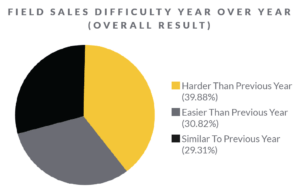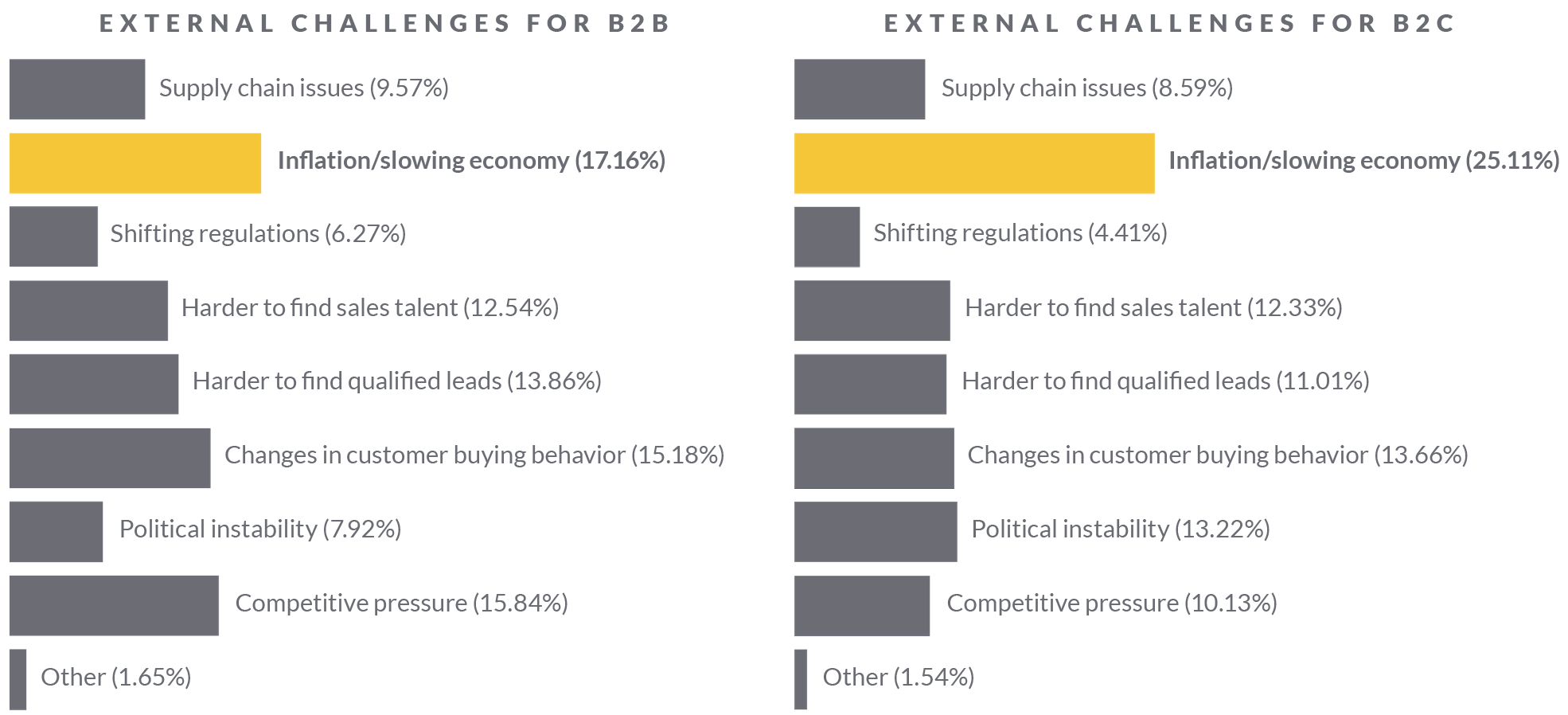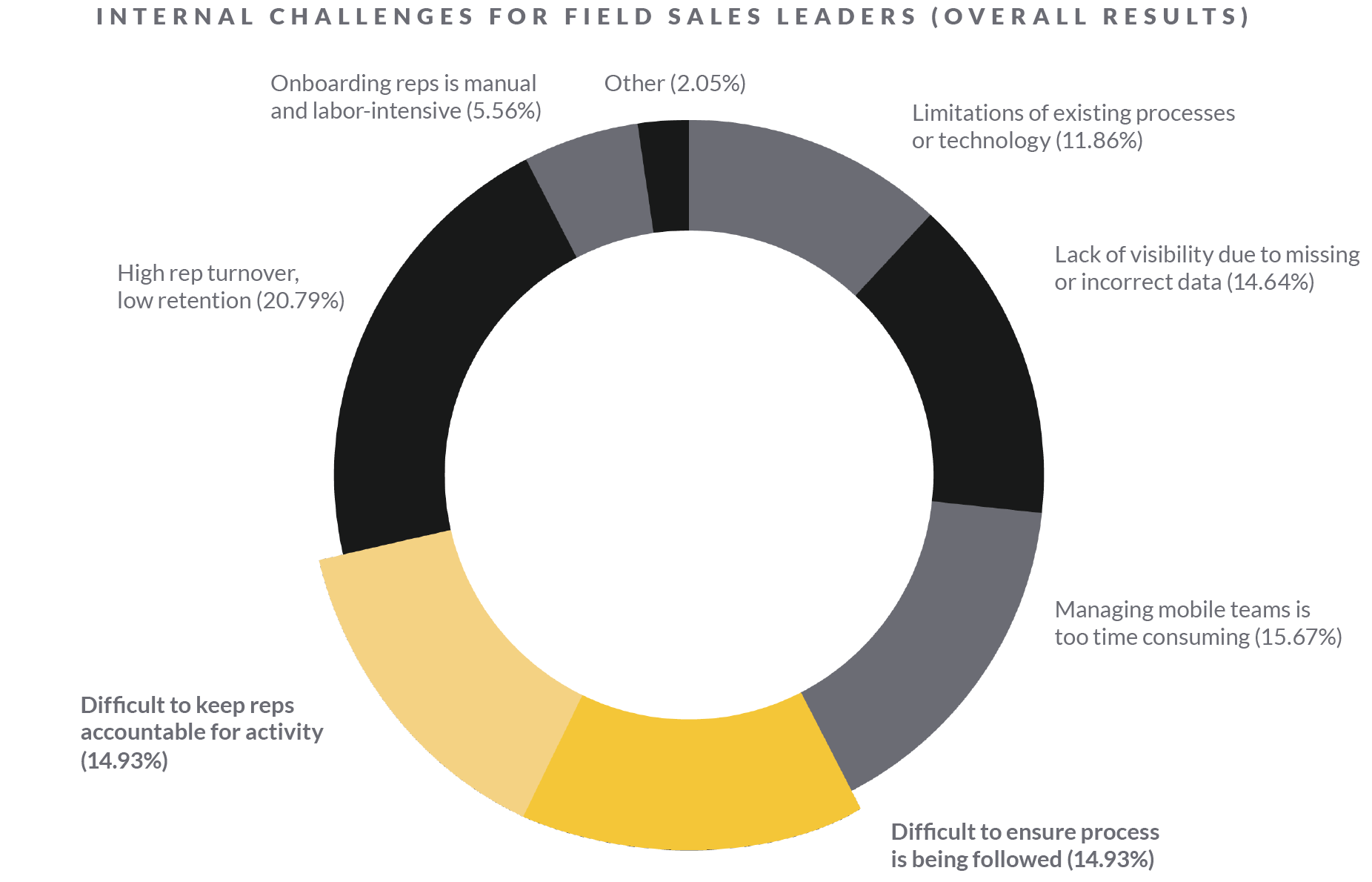Introduction
The field sales industry has changed significantly in the past few decades. The last couple of years, in particular, have really turned the industry on its head. This fact has led many professional sellers to ask themselves, “What happens next?” Will the industry continue to evolve? If so, how?
One of the biggest changes that we see has to do with complexity. Most people we spoke to for this report believe that field sales is more difficult now than it was 12 months ago.
So, we wanted to know: What challenges do modern field sales teams face? How are top organizations overcoming them? And which technology solutions prove most helpful? To answer these questions, we surveyed hundreds of sales professionals, ranging from entry-level reps to experienced managers.
By the end of this report, you’ll know exactly where the field sales industry stands. More importantly, you’ll have the information you need to navigate it effectively. Keep reading to discover what we learned—and how you can apply this knowledge to your own sales career to achieve more success.
Outside Sales Trends and Challenges
Field Sentiment and Performance
Are field sales getting more difficult? Survey respondents share their views on the industry at large, and how their specific teams have performed over the past 12 months.
The majority of sales reps (39%) agree field sales are harder now than it was in the past. This sentiment isn’t necessarily shared across industries, however.
DIGGING DEEPER: Nearly 50% of the survey respondents in the B2C and/or residential sales segment believe winning deals has become more challenging in the last year, compared to just 29% of B2B sellers. That’s not to say that B2B selling is easy. But those in the B2C space seem to experience more difficulties in 2023.
Closing deals in 2023 may be more difficult, but that hasn’t stopped most sellers. Only 7.45% of the sales reps we surveyed for this report have experienced revenue decline. Even better, 67% of respondents have actually grown revenue in the last year.
DIGGING DEEPER: Once again, there is a stark difference between B2B and B2C segments. 78.95% of B2B sellers report some or significant YoY revenue growth, compared to 59.21% of B2C sellers.
WHY IT MATTERS: Field sales are in constant flux, but the teams we surveyed for this report have shown remarkable resilience in the face of tough challenges. This fact is proven by the average YoY revenue growth that most survey respondents have achieved. Regardless of circumstances, the best sellers find ways to drive revenue.
External Challenges
What struggles face the average field sales team in 2023? Survey respondents weigh in on the top external challenges impacting their sales organizations.
Knowing that your sales organization faces challenges is one thing. Understanding what those challenges are and why they exist is another. According to our survey results, the number one challenge that sales reps face in 2023 is slowing economic growth.
As you would expect, both B2B and B2C markets have difficulty qualifying leads, finding sales talent, and adapting to changes in customer buying behavior. These age-old problems were the next most prominent challenges that survey respondents faced in 2023.
DIGGING DEEPER: Economic factors have a disproportionate effect on the B2C market. 25% of B2C sellers have been impacted by the economy, compared to just 17% of B2B sellers.When it comes to the B2B segment, 15.84% of sellers say their biggest challenge is competitive pressure—a more than 50% increase compared to the B2C segment (10.13%).
WHY IT MATTERS: Economic downturns often reveal deep-rooted issues. This is especially true for residential field sales teams that rely on consumer financing options to close deals. (When rates rise, fewer people qualify for financial assistance, which shrinks the buying pool.)
Companies that face economy-related challenges can continue to excel in economically unstable times by adopting a more selective targeting process. Field sales teams can improve productivity by focusing on top-level buyers and pre-qualifying them before engaging them in detailed sales conversations. This “quality over quantity” approach will result in fewer prospects but allow sellers to focus on deals that drive revenue.
Internal Challenges
What internal factors prevent field sales teams from doing their jobs? Survey respondents in both sales management and representative roles explain the obstacles they face.
Sales reps and sales managers have different jobs. So it’s only natural that they would experience different challenges. According to survey results, the biggest challenge that sales leaders face revolves around rep turnover.
DIGGING DEEPER: 28.75% of B2C sales organizations and 13.37% of B2B sales organizations have trouble retaining sales talent. We will be covering turnover and retention in a later section.
Other top challenges identified in our survey include managing remote teams in an efficient manner, ensuring proper processes are followed, and collecting data that leads to visibility.
We see that rep accountability is a major issue for most sales leaders. Nearly 30% of survey respondents claim to have trouble tracking rep activity and ensuring the actions they do take follow proper company protocols.
What keeps sales reps from making quota? If you knew the answer to that question, you could revolutionize your entire sales process. The results of our survey may give you valuable insight into that question. According to respondents, changes to buyer finances (15.77%) and finding qualified prospects (15.67%) are the two most likely reasons for missed quota.
DIGGING DEEPER: We find that B2C sellers are particularly vulnerable to experience/skill deficiencies, sales process friction, and time management issues. B2B sellers, on the other hand, struggle to maintain peak productivity levels and pinpoint qualified prospects.
WHY IT MATTERS:Rep turnover will always be an issue for sales teams, regardless of industry and/or team performance. This is the nature of the business. As long as your company stays within acceptable limits, rep turnover shouldn’t adversely impact your organization.
Instead, field sales teams should focus their efforts on improving visibility. You must hold your reps accountable, ensure team processes are regularly followed, and that company data is accurate. If you don’t, you won’t be able to lead your sales team effectively.
This is perfectly clear when it comes to quota attainment. When asked why reps don’t make quota, 43% of the answers we received related to “Experience/Skill,” “Time Management,” and “Sales Process”. Fortunately, many of these issues can be remedied through training. But sales managers will only know that these problems exist if they have clear visibility into their sales teams, as few field sales reps will admit they’re struggling or why said struggles occur.
Summary
Since Covid, field sales teams across the industry have been dealing with increasingly difficult challenges and near-constant change. Economic factors have been a major contributing factor to the increased challenge from the last year. These conditions are likely going to persist in the years to come, so it is important that organizations be adaptable to remain competitive in a more difficult market.
To excel in such times, a selective targeting approach is vital. By focusing on top-level buyers, pre-qualifying them, and prioritizing revenue-generating deals, teams can boost productivity. Rep turnover, a persistent issue, demands improved visibility and accountability. Holding reps accountable, ensuring process adherence, and gaining clear insights into sales teams is crucial for effective leadership and addressing low quota attainment. Training can address skill and process-related issues, but visibility is key as reps rarely admit struggles.
Despite mixed outlooks on whether these hardships will get easier in the next 12 months, a significant majority of B2B and B2C field sales organizations plan to increase head counts, underscoring the need for proactive measures and strategic adjustments to overcome challenges and seize opportunities to grow.
Want to learn more about the metrics that drive the field sales industry? Download the entire SPOTIO “State of Field Sales” report here!










